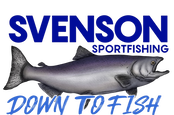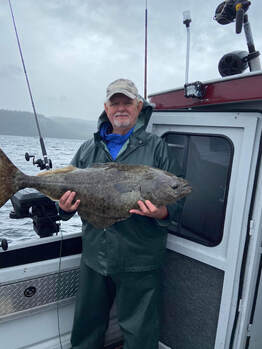|
In addition to being called the "salmon capital of the world," Ketchikan, Alaska is also an ideal location for halibut fishing. Thanks to its unique location and geography, Ketchikan's coastal waters boast an abundance of pacific halibut. The nutrient-rich channels of the Inside Passage create the ideal habitat for halibut to thrive.
From May through September, the weather is particularly mild and the waters are calm, providing excellent halibut fishing opportunities. Whether you prefer to hire an experienced guide or fish on your own, Ketchikan has something to offer for everyone. Halibut Fishing Regulations in Ketchikan - Playing by the Rules
It is essential to keep in mind that fishing regulations for halibut fishing can vary depending on where you are from. Out-of-state visitors must adhere to both the catch-limit and the size limit restrictions imposed by ADFG and NOAA throughout Southeast Alaska.
To preserve the local halibut population, the daily bag limit for visitors on guided trips is one halibut per person. In order to keep a halibut, it must be either less than 40 inches or greater than 80 inches in length. This means that any halibut that fall within that size limit range must be released back into the water. For unguided fishing trips, individuals have a daily possession limit of two halibut per day of any size. Aside from the catch limits and size restrictions, all visitors must also purchase fishing licenses from the ADFG website. The cost of a license varies depending on the length of the trip. There are 1-day, 3-day, 7-day, and 14-day options. Unguided Fishing Trips - What to Expect
For those that wish to try catching on their own, halibut fishing from shore is not really an option. While it is potentially possible, it can be difficult to catch halibut from land. The best time to fish for halibut from shore is usually never, but a low tide could provide opportunities as the fish are closer in.
A fisherman should have a sturdy mid-length rod, strong line, and a reel with high-line capacity. Halibut fight in bursts, and it is not uncommon for them to pull line out of the reel. Large, circle shaped hooks help ensure that the fish does not come off once hooked. "J" hooks are also used when the halibut are not biting aggressively. Despite having the correct equipment, the biggest challenge for anglers can be finding the right spot to fish.
Guided Fishing Excursions for Out-of-State Visitors
Peak Season for Halibut Fishing in Ketchikan
June, July, and August are considered the peak months for halibut fishing in Ketchikan. During these months, the fish are generally more active. Fishermen have a better chance of catching halibut that are returning to feeding areas in the early summer.
Halibut are available year-round and some fishermen prefer to fish during the shoulder seasons of May and September, when there are fewer crowds. However, the middle of the summer provides the best chance to reel in a big one. Visitors seeking more information
Coming prepared for an Alaskan fishing trip is key in ensuring an excellent vacation. For anglers looking for more resources, they can check out the Alaska Fish & Game website and the halibut fishing page of our website.
Svenson Sportfishing Team
Ketchikan, Alaska is home to a wide variety of fish, and the Alaska Department of Fish and Game requires all anglers to purchase a license to engage in fishing of any kind. Without a doubt, salmon are the most sought-after on charters, but many anglers come to Ketchikan to try their luck fishing for halibut, lingcod, and other bottom fish.
With the exception of the King Salmon Stamp, anglers only need one license to participate, the most common being the One-Day Sport-fishing license. A one-day license allows anglers to target all species of fish; there is no special license required to fish for halibut. Anglers are allowed to fish one rod per person, regardless of whether they are on a charter or leisure fishing on their own time. To validate a license, anglers must have a signed and printed copy on the boat with them while they are fishing. The Alaska Department of Fish and Game provides exemptions on fishing licenses for seniors and youth. Unfortunately, the senior exemption only applies to Alaska residents who are age 60 and older, but resident and nonresident (out-of-state) youth can enjoy similar exemptions. For Alaska residents age 17 and younger, or nonresidents age 15 and younger, the Department of Fish and Game does not require the purchase of a fishing license. However, resident and nonresident youth are still required to hold a Sport Fishing Harvest Record Card in order to keep record of their catch. Residency requirements depend on the amount of time that an individual has lived permanently in the state of Alaska. Costs for Different Fishing Licenses
Resident Annual Sport Fishing License: $20.00
Resident Annual King Salmon Stamp: $10.00 Nonresident 1-Day Sport Fishing License: $15.00 Nonresident 3-Day Sport Fishing License: $30.00 Nonresident 7-Day Sport Fishing License: $45.00 Nonresident 1-Day King Salmon Stamp: $15.00 Nonresident 3-Day King Salmon Stamp: $30.00 Nonresident 7-Day King Salmon Stamp: $45.00 Best Practices to Come Prepared
The best move is to purchase your fishing license online on the Alaska Fish & Game website before your trip. You can also purchase a fishing license at the marina, but this could take away from valuable fishing time.
Print the fishing license, sign it and set a reminder to bring the license with you. The King Salmon Stamp is a purchase you can make in addition to your license. Guests who are not fishing do not need a license. Svenson Sportfishing Team |
Svenson Sportfishing TeamAxel Svenson, Leif Svenson, Conner Vacca, and Sammy Vacca. ArchivesCategories |
Svenson Sportfishing
708 North Point Higgins Road
Ketchikan, AK 99901
708 North Point Higgins Road
Ketchikan, AK 99901
|
Call or Text:
(425) 449-9884 Alternate Phone: (907) 617-7465 |




 RSS Feed
RSS Feed